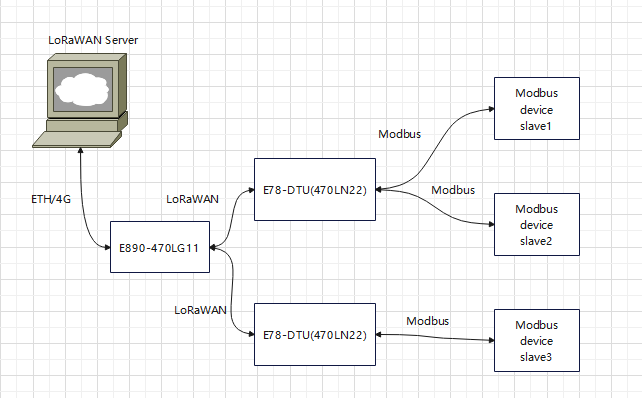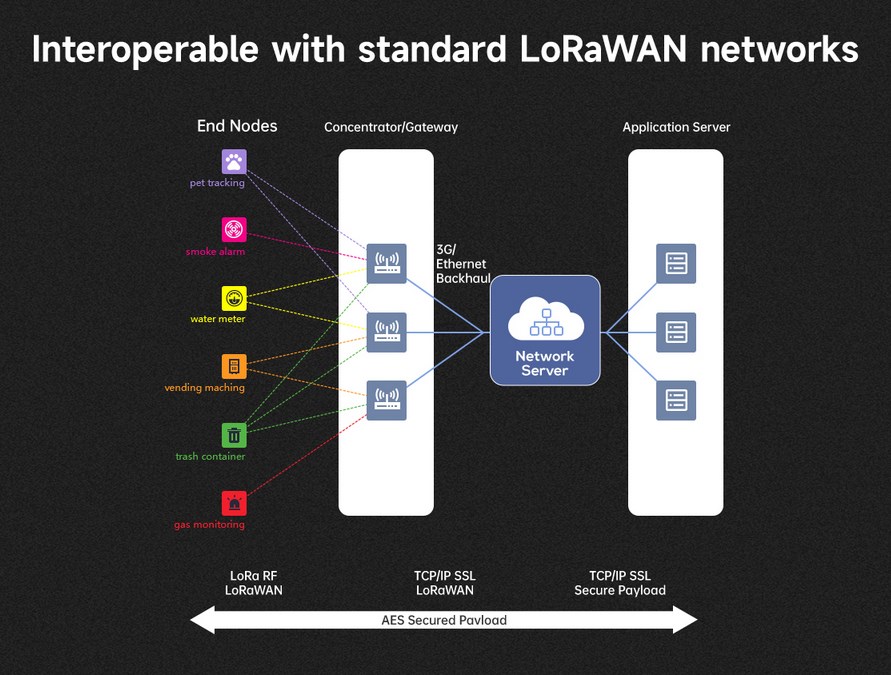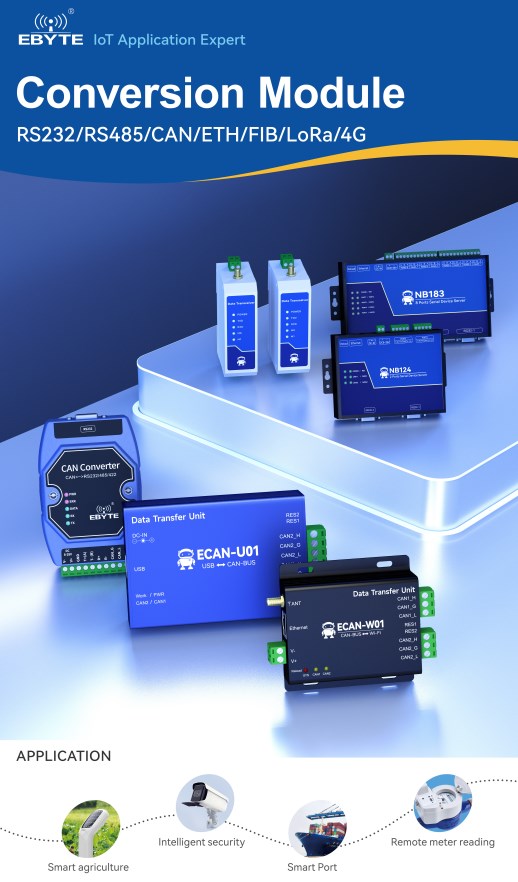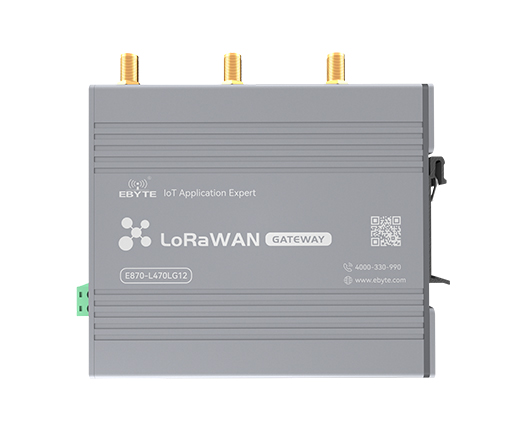

Foreword introduction
As a China Lorawan gateway Manufacturer and Lorawan node modules Factory, CDEBYTE focuses on providing wholesale Lorawan gateway and Lorawan node modules. Supports standard LoRaWAN network protocols, and access to standard LoRaWAN servers such as TTN, Tencent, and open-source chip stack. The instructions are simply configured to access the standard LoraWan In the network, it's a great choice for current IoT applications.
Content Express here:
LoRaWAN overview introduction
Simply put, LoRaWAN is a derivative of LoRa technology. It fully utilizes the radio frequency characteristics of LoRa and adds anti-collision, data encryption, rate adaptation, gateway multi-path concurrent reception and other features. It is a set of standardized communication protocols and system structure. Characterized by low power consumption, wide coverage, ultra-low cost, and large network capacity, LoRaWAN is a star topology that has great advantages in maintaining low power consumption and increasing communication range.
One of the biggest advantages of LoRaWAN is that it can operate in unlicensed spectrum, which is very different from mobile phones. The fees and costs and private network deployment are much cheaper. Therefore, using LoRaWAN, a private network can be established.
Comparison between LoRaWAN and LTE NB-IoT and Wi-SUN
LoRaWAN is a low-power, wide-area network (LPWAN) protocol targeting battery-powered devices. While many wireless connectivity protocols use the LTE band, Semtech designed LoRaWAN for use in the Industrial, Scientific, and Medical (ISM) band, a communications highway that is unlicensed.
Related article :LoRa Basics: Best Practices for LPWAN Technology Implementation
NB-IoT is similar to LoRaWAN in that it is also an LPWAN protocol. However, the technology operates in three unique ways: Standalone. On the unused 200 kHz (GSM) band, or on LTE base stations, which typically reserve blocks of resources for related operations, usually within guard bands, which are narrow bands of frequency that separate larger bands that are already in use, preventing interference. and congestion. These only account for about 10% of the bandwidth available in LTE networks.
Related article :
Brief introduction of GPRS, 4G, NB-IOT wireless communication module
Wi-SUN is a network protocol based on a mesh topology, unlike star-based Wi-Fi or LTE. Wi-SUN supports star, mesh, and hybrid topologies. Wi-SUN is typically deployed following a mesh architecture, where each node relays data to the network. Additionally, Wi-SUN devices operate on AC power and battery power. Wi-SUN is based on IEEE 802.15.4g as the underlying protocol, and its upper-layer configuration files depend on the application. The creation of Wi-SUN profiles, certification to ensure interconnectivity and its popularization activities are implemented by the Wi-SUN Alliance.
RS485 to LoRaWAN data collector
In daily enterprise production, traditional serial port equipment such as RS485, RS232, RS422 and other interfaces have been widely used. However, in real-life automated production, it is often necessary to achieve data communication of hundreds of meters or even thousands of meters. To achieve remote monitoring, it is necessary to You will face these problems:
|
When the Internet of Things technology came out, this problem was solved by the RS485 to LoRaWAN data collector. Using LoRa wireless technology and LoRaWAN gateway, the complex wiring was successfully eliminated and wireless communication replaced wired communication.
Working principle
Data collection: The data collector is first connected to RS485 devices, such as sensors, instruments or other monitoring equipment, through the RS485 interface. RS485 communication allows the data logger to read data from these devices.
Related article :
Detailed explanation of data wireless transmission between Ethernet and rs232 and rs485 interface
Data processing: Once the data collector reads data from the RS485 device, it may need to perform data processing, including data parsing, unit conversion, verification and other data processing tasks to ensure the accuracy and availability of the data.
LoRaWAN communication: The processed data is encapsulated and sent to the LoRaWAN network through the LoRaWAN communication module. The LoRaWAN communication module is responsible for encoding data into packets of the LoRaWAN protocol and sending the data to one or more LoRaWAN base stations using LoRa modulation.
LoRaWAN base station: The LoRaWAN base station receives data from the data collector and then forwards it to the LoRaWAN network server. These base stations are typically spread over a wide geographical area to cover the entire application area.
LoRaWAN Network Server: The LoRaWAN network server receives and parses data from the base station and then transmits the data to the cloud or application server. Here, the data can be further processed, stored and visualized.
Cloud or application server: Ultimately, data can be analyzed, monitored, and reported in the cloud or application server. Users can access and manage this data through the app or web interface
Outstanding advantages
The RS485 to LoRaWAN data collector is a data collector that uses the standard LoRaWAN protocol for the uplink wireless interface and the RS485 interface for the downlink interface. It can transparently transmit the ModBus protocol to the server through the LoRaWAN wireless network to realize wireless transmission of industrial site control signals. .
Products Recommended

The E78-DTU (470LN22) developed by CDEBYTE is a data collector suitable for industrial environments. Its uplink wireless interface adopts the standard LoRaWAN protocol, supports the CN470 regional file communication frequency band, and is configured with 1 RS485 serial port. It can be used in complex industrial sites It can also provide effective communication coverage. It has the following characteristics:
Support LoRaWAN 1.0.2/1.0.3 protocol
RS485 to LoRaWAN two-way transparent transmission
LoRaWAN CLASS A and CLASS C two modes
LoRaWAN OTAA and ABP two network access methods
ModBus polling, supports up to 64 polling instructions
Active query function, which can issue read instructions from the remote server to read RS485 bus data

The product's command storage function is a function worth using. When no command is received from the LoRaWAN gateway, it can also actively poll the devices on the RS485 bus to achieve the purpose of regularly reporting RS485 bus device data, thus reducing the need for LoRaWAN gateways. reduce the workload, issue fewer instructions, reduce network bandwidth usage, and avoid network congestion.

Ebyte cooperates with Semtech
Semtech is a leading supplier of high-performance analog and mixed-signal semiconductors and advanced algorithms for infrastructure, high-end consumer products and industrial equipment. Semtech's LoRa device cloud platform is a globally adopted remote low-power solution for IoT applications, enabling the rapid development and deployment of ultra-low-power, cost-effective remote IoT networks, gateways, sensors, module products and things around the world. Internet services.
CDEBYTE is the first to cooperate with Semtech and has independently developed more than 100 LoRa modules and equipment, with transmission distances from 1km to 40km, meeting various medium and long-distance transmission application scenarios. The products are exported to more than 50 countries and regions around the world.
 |  |  |
 |  |  |
Ebyte outdoor LoRaWAN gateway
Different from the indoor transmission design of other gateways on the market, the transmission distance of indoor transmission gateways can usually only reach about 200 meters, which meets the indoor transmission needs. The outdoor transmission gateway specially developed by EBYTE can have a transmission distance of up to 3,000 meters. meters, which is more than 10 times that of other indoor gateways.
 | E890-L470LG12 Full Duplex LoRaWAN Gateway [Chip scheme]:SX1302 [Working frequency band]:CN470 [Transmit power]:27dBm [Communication distance]:3km [Product weight]:417±5g [Product size]:116*105*41mm [Introduction]:Full Duplex LoRaWAN Gateway |
Features
Supports 4G+ Ethernet two-way connection, stable and reliable;
Support wired and wireless simultaneous online and multi-network intelligent switching;
Support firmware upgrade and firmware configuration backup function;
Supports firewall, NAT, DMZ host, access control black and white list, IP speed limit and other functions;
Supports QOS traffic service, which can limit the speed according to the interface;
Support VPN client;Supports load balancing multi-network port flow control settings, with network port priority, enablement, flow control ratio and other working modes;
Supports 1 wired WAN port, switchable LAN port;
Support LORAWAN gateway;
Support LED status monitoring;
Support Web platform management configuration method;
Supports one-click restore to factory settings;
Supports wired network port 10/100Mbps rate.
- Summary of ZigBee Protocol: ZigBee 3.0 VS ZigBee Pro
- Global Attention: Groundbreaking Discovery of Room-Temperature Superconductivity
- An overview of the matter protocol
- Network Topology Guide: Guide You To Understand 5 Common Network Topologies
- Protocols Between Lorawan Gateways and Common Web Servers










